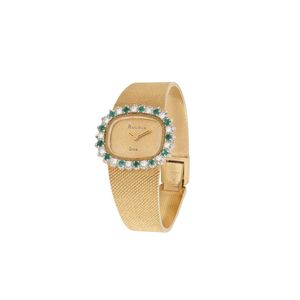Bulova 14ct Gold Emerald & Diamond Bracelet Watch (1970)
Bulova a lady's 14ct gold emerald and diamond-set bracelet watch circa 1970, dial: textured gilt, signed by Dior, calibre: manual winding, fully jewelled, case: polished cushion-form, diamond and emerald-set bezel, snap on case back case number: 47301, closure: integral 14ct gold textured link bracelet and folding clasp, dimensions: 28 mm diameter, overall length approximately 155 mm, accessories: none
You must be a subscriber, and be logged in to view price and dealer details.
Subscribe Now to view actual auction price for this item
When you subscribe, you have the option of setting the currency in which to display prices to $Au, $US, $NZ or Stg.
This item has been sold, and the description, image and price are for reference purposes only.
- Emeralds - Emeralds have been used in jewellery making for thousands of years, and are prized for their deep green colour, which is caused by the presence of chromium and vanadium in the mineral beryl. Because of their rare colour, emeralds are often more valuable than diamonds of a similar size and quality. In jewellery making, emeralds are typically cut into round or oval shapes to maximize their color and clarity. They are often set in gold or platinum and used as the centrepiece of a piece of jewellery, such as a ring or necklace. They can also be used in combination with other gems, such as diamonds, to create intricate and beautiful designs.
- Bezel - On a clock or watch, the bezel is the metal frame into which the watch or clock glass is fitted. In clocks, the bezel may include a hinge and a flange, in effect a door to the face of the clock. In jewellery the bezel is a band of metal with a projecting lip that holds the gemstone in its setting.
- Circa - A Latin term meaning 'about', often used in the antique trade to give an approximate date for the piece, usually considered to be five years on either side of the circa year. Thus, circa 1900 means the piece was made about 1900, probably between 1895 and 1905. The expression is sometimes abbreviated to c.1900.
This item has been included into following indexes:
